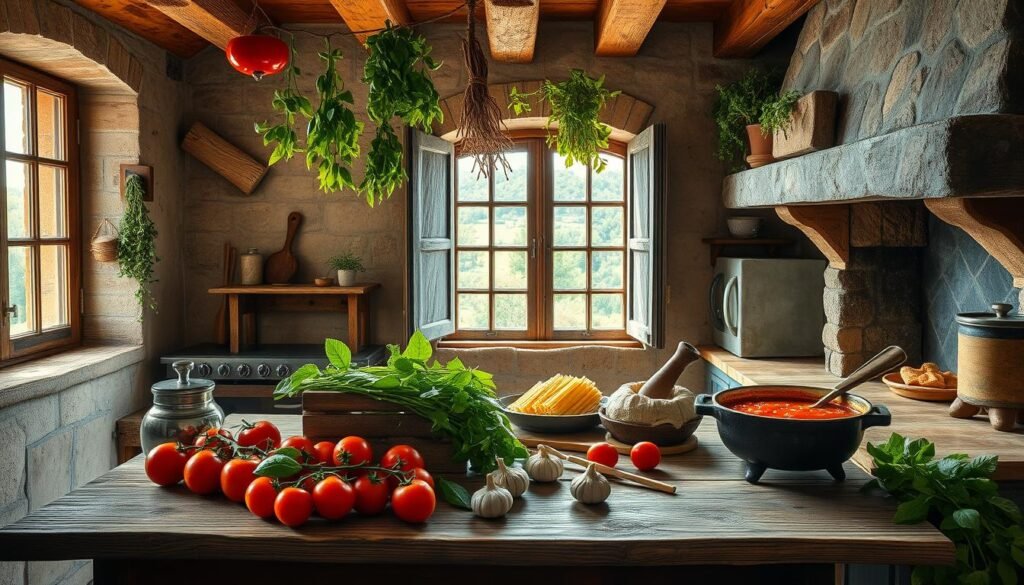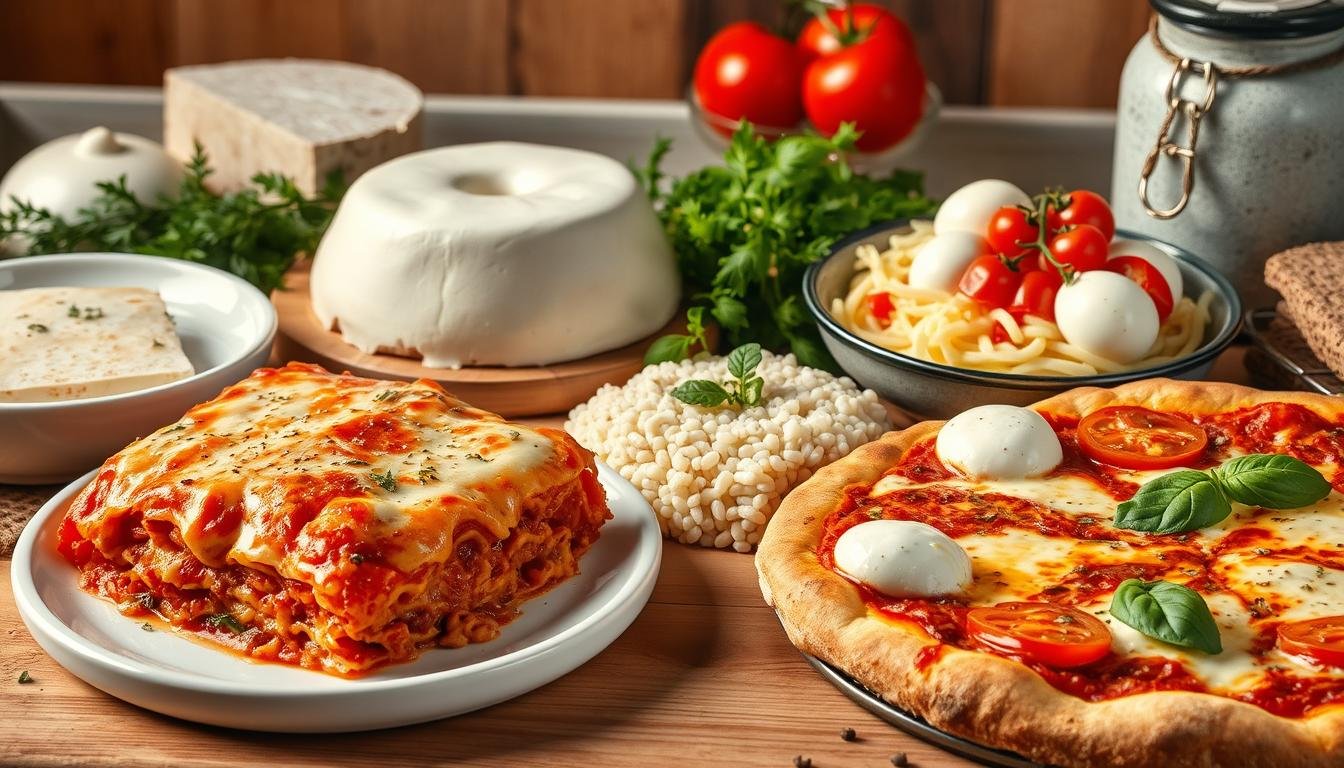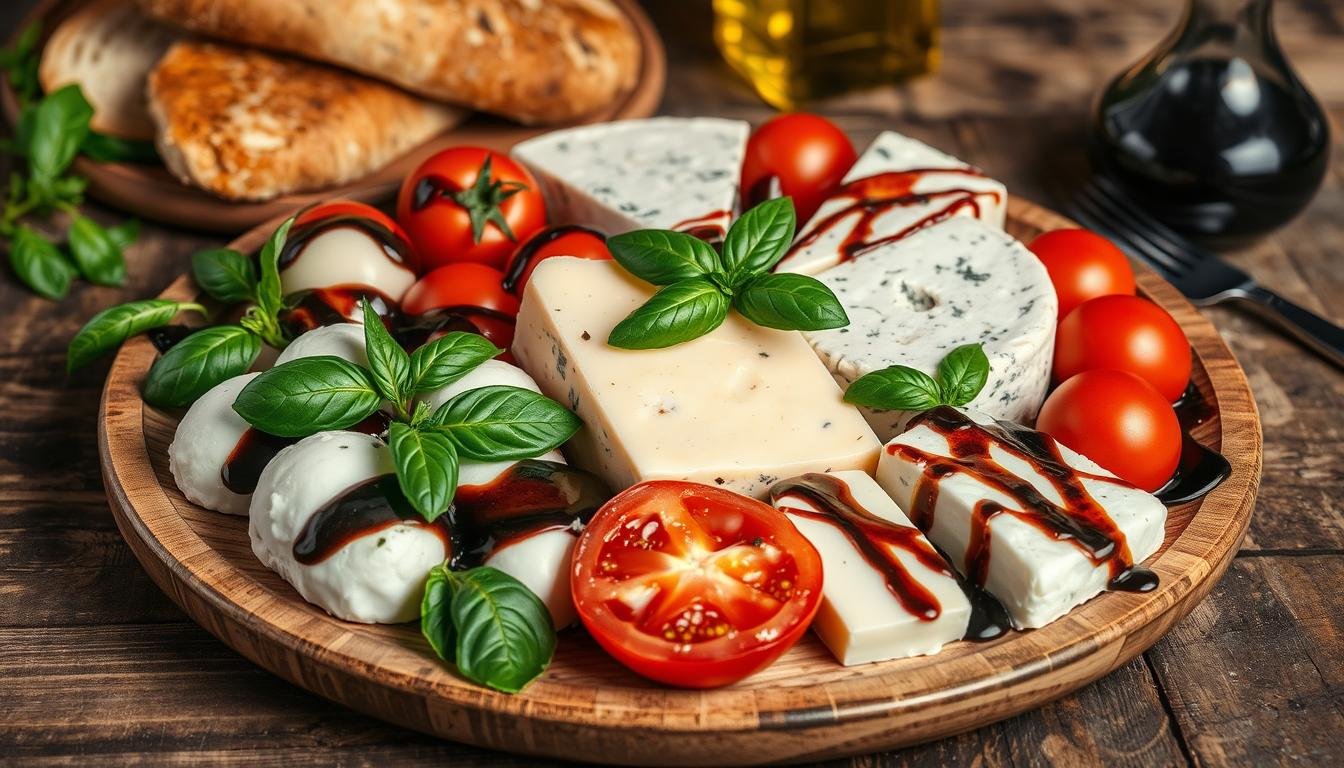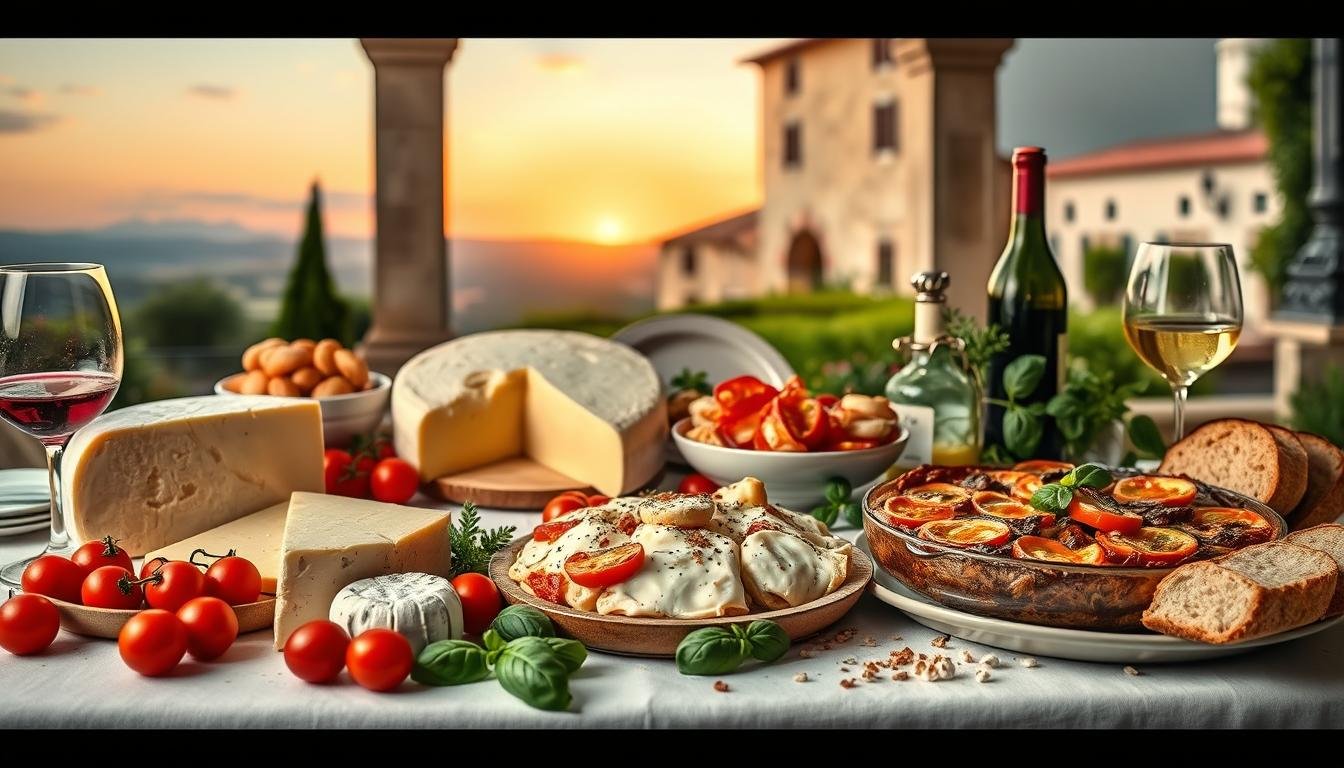Did you know there are 91 results for “10 Seasonal Italian Recipes to Try”? This shows how rich and varied Italian cuisine is. You can find dishes with 5 stars to 0, taking you on a tasty trip through Italy.
Try making Italian dinner recipes at home. You can make crescent-shaped pasta, woven lasagna, and even fried risotto pancakes. These dishes highlight fresh ingredients and traditional tastes. They’re perfect for family dinners and special occasions, bringing Italy to your table.
Key Takeaways
- 91 results displayed for “10 Seasonal Italian Recipes to Try”
- Ratings vary from 0 to 5 stars, with the highest at 540 ratings and the lowest at 5
- Recipes showcase a variety of Italian classics, from risotto to pasta and pizza
- Seasonal ingredients are the star, celebrating the best of each time of year
- Recipes are suitable for family meals and gatherings, offering an Italian-inspired feast
Introduction to Seasonal Italian Cuisine
Italian cooking is all about loving seasonal, regional dishes. Chefs use fresh ingredients to bring out the true taste of Italian flavors. This bond between the kitchen and the land makes each dish special.
The Importance of Seasonal Ingredients
In Italy, using seasonal ingredients is more than a choice. It’s a way of life. Chefs plan menus with the freshest, local produce in mind. This ensures dishes are full of flavor, nutritious, and sustainable.
Spring asparagus, summer tomatoes, and winter root veggies are just a few examples. Each season offers a variety of fresh ingredients perfect for Italian cooking.
Why Italian Recipes Shine with Fresh Produce
Italian cuisine is simple yet elegant. It lets fresh ingredients be the star. Chefs use the best, seasonal produce to highlight the natural flavors of the food.
This approach makes meals both healthy and satisfying. It’s all about letting the ingredients speak for themselves.
“In Italy, we don’t have the same obsession with âfusiontâ cooking as they do in other parts of the world. Our focus is on cooking with integrity, letting the quality of the ingredients speak for themselves.” – Massimo Bottura, renowned Italian chef
Spring Delights: Asparagus Risotto
As spring arrives, the days get longer and the air gets crisper. This season brings a wealth of fresh produce to enjoy. Among these delights is the classic asparagus risotto. It’s a dish that perfectly represents Italian cooking, with its perfect mix of flavors and textures.
Key Ingredients for the Perfect Risotto
The base of a great risotto is the rice. For this recipe, Carnaroli and Arborio are the best choices. They make the risotto creamy and al dente. Fresh asparagus adds a nice crunch and sweetness. And Parmesan cheese brings a savory, nutty flavor.
Cooking Techniques to Master
- Toasting the rice: This step enhances the rice’s flavor and texture.
- Gradual stock addition: Adding stock slowly, while stirring, helps the rice absorb it well.
- Achieving the perfect texture: You want the risotto to be creamy but still have a bit of bite.
Learning these techniques will help you make an authentic Italian asparagus risotto. It’s a dish that highlights the season’s best produce and honors Italy’s culinary traditions.

“The essence of spring Italian cooking is perfectly captured in this asparagus risotto, where the delicate flavors of the season come together in a harmonious and comforting dish.”
Summer Freshness: Caprese Salad
When the sun is out, nothing beats a Caprese salad. This Italian dish comes from Capri and looks like the Italian flag. It has juicy tomatoes, fragrant basil, and creamy mozzarella cheese. Each fresh ingredient is showcased beautifully.
Classic Ingredients and Variations
The traditional Caprese salad has a few key parts. It includes ripe tomatoes, fresh mozzarella cheese, and basil leaves. These are often dressed with extra virgin olive oil, sea salt, and black pepper.
While the original is great, Caprese can also be creative. Try adding balsamic vinegar or glaze for a sweet and tangy twist. Fresh peaches, nectarines, or strawberries can also add a nice touch, highlighting the season’s fresh ingredients.
Pairing with the Right Vinegar
The secret to a great Caprese salad is finding the right balance of flavours. Tomatoes, mozzarella, and basil are the base. The right vinegar, like a balsamic reduction or glaze, adds acidity and sweetness.
“The simplicity of Caprese salad allows the quality of each ingredient to truly shine. It’s a perfect showcase of healthy Italian meals and fresh ingredients.”
Looking for a light starter or a main course? Try the Caprese salad. Its vibrant colours, bold flavours, and flexibility make it a summer favourite. It’s sure to impress your taste buds and leave you wanting more.
Autumn Flavours: Pumpkin Ravioli
As autumn arrives, the kitchen buzzes with Italian flavors. Pumpkin ravioli is a highlight, filled with a creamy squash mix. It’s a taste of the season in every bite.
The Art of Making Fresh Pasta
Making pumpkin ravioli from scratch lets you control the flavors. Start with an egg-based dough, kneading it until it’s smooth. Roll it thin, then cut into squares for the ravioli.
Be gentle when working the dough. This keeps it tender and perfect for filling.
Sauces that Complement Pumpkin Ravioli
Choosing the right sauce is crucial. A brown butter sauce with sage is a classic choice. It pairs well with the pumpkin’s sweetness.
For something different, try a maple-Dijon dressing or a light tomato sauce. They add a nice balance to the dish.
Pumpkin ravioli is a feast for the senses. It’s a mix of autumn’s flavors and homemade love. Whether you’re a pro or a beginner, this dish will wow you.

Winter Warmth: Osso Buco
As winter comes, nothing warms you up like Osso Buco. This dish from Milan is a true Italian classic. It’s made with slow-cooked veal shank, rich sauce, and tender meat. It’s perfect for a cozy winter night.
Traditional Ingredients and Preparation
Making authentic Osso Buco is all about the traditional way. It uses veal shanks braised in white wine, broth, and veggies. This slow cooking makes the meat tender and the sauce full of flavour.
To make the perfect Osso Buco, you’ll need:
- 500 grams of grass-fed veal shanks
- Onions, carrots, and celery for the aromatic base
- Dry white wine, such as Sauvignon Blanc or Chardonnay, for deglazing
- Tomato paste and canned crushed tomatoes
- Herbs like bay leaves, thyme, and parsley
Serving Suggestions for a Cozy Meal
Osso Buco is best with risotto alla Milanese. This saffron-infused rice is creamy and golden. You can also serve it with soft gnocchi or a green salad for a lighter touch.
For extra warmth, top it with gremolata. This mix of lemon zest, garlic, and parsley adds freshness. It balances the dish’s richness, making it a complete meal.
Celebrating Seasonal Fruits: Figs
Figs are plentiful in late summer and early autumn. They are a key ingredient in Italian cooking. These sweet fruits go well with both sweet and savoury dishes. They highlight the Italian love for seasonal cooking and fresh ingredients.
Fig and Prosciutto Salad
Mix fresh figs, thin slices of prosciutto, and balsamic glaze for a simple yet fancy salad. The mix of salty and sweet is amazing. Add toasted pine nuts for extra crunch.
Fig Tart: A Classic Dessert
Finish your meal with a fig tart. The crust is buttery and flaky, perfect for honey-glazed figs. Top it with whipped cream or vanilla ice cream for a treat.
Figs are a seasonal gem in Italian cooking. They’re great in salads or tarts. Enjoy their sweetness and versatility to make dishes that celebrate the season.

Exploring Herbs: Basil in Italian Cooking
Basil is a key part of traditional Italian flavors and many authentic Italian dishes. Its fresh, peppery taste is loved in summer. This is when basil grows best and adds its unique aroma to food.
Basil Pesto: A Versatile Condiment
The famous Genovese basil pesto is a highlight of Italian cooking. It comes from Genoa and celebrates basil’s taste. Made with basil, pine nuts, garlic, Parmesan, and olive oil, it’s great on pasta, bread, or veggies.
Using Fresh Basil in Summer Dishes
Fresh basil makes summer dishes special. It’s perfect in Caprese salads with tomatoes and mozzarella. It also adds flavor to tomato sauces and pizzas.
Basil brings Italy’s sunny vibe to your kitchen. It’s great for simple dishes or big feasts. Adding basil makes any meal a celebration of traditional Italian flavors.

“Basil is the ‘King of all herbs’ – its presence in a dish signals that you are in the presence of true Italian cooking.”
Sourcing Local Ingredients in Australia
Preparing authentic Italian cuisine starts with the right ingredients. Australia has plenty of fresh, high-quality produce for your dishes. You can find everything from farmers’ markets to specialty food stores.
Best Markets for Italian Ingredients
Begin at your local farmers’ market. These places are full of fresh, seasonal produce. You’ll find tomatoes, herbs, and vegetables perfect for Italian cooking.
Many markets also have stalls with artisanal olive oils, cheeses, and cured meats. These are key to authentic Italian flavours.
For a wider selection, visit specialty food stores focused on Mediterranean and European items. They carry top-quality Italian imports like pasta, sauces, olives, and balsamic vinegar. These stores can also introduce you to unique Italian products.
Supporting Local Farmers and Producers
Choosing local ingredients for your Italian cooking is rewarding. It makes your dishes taste great and supports the Australian food industry. It also helps the environment by reducing food miles.
Engage with farmers, producers, and artisans at markets and stores. Learn about their practices and the stories behind their products. This connection adds authenticity and appreciation for Italy’s regional flavours, while supporting Australian goods.

“The secret to great Italian cooking is using the best, freshest ingredients you can find.”
Italian Cooking Techniques to Embrace
To make real Italian dishes and get the true taste of traditional Italian flavors, you need to learn key cooking skills. These include sautéing and slow cooking. These methods can make your Italian meals at home even better.
Importance of Sautéing and Simmering
Sautéing is key in Italian cooking, for things like risottos and pasta sauces. It’s about cooking ingredients like onions and garlic right to get deep flavors. Simmering is also important, for dishes like osso buco, to get the right texture.
Learning these techniques lets you make the Italian flavors you love.
The Role of Slow Cooking
Slow cooking is a big part of Italian cooking, making dishes richer and more flavorful. Braising and stewing, as in osso buco, let flavors mix and meat get tender. Slow cooking makes dishes taste better and brings out the real taste of authentic Italian dishes.
By mastering sautéing, simmering, and slow cooking, you unlock the full potential of your Italian dishes. With practice, you can improve your cooking and enjoy traditional Italian flavors at home.

“The secret to great Italian cooking is using high-quality, fresh ingredients and letting the flavors speak for themselves.”
Pairing Italian Dishes with Wines
Understanding wine pairing can elevate your Italian meals. Whether it’s a summer salad or a winter stew, the right wine can make a big difference. It brings out the best in your regional Italian specialties.
Choosing the Right Wine for Each Season
Seasons change, and so should your wine choice. In summer, light and crisp white wines like Pinot Grigio or Verdicchio are great. They match well with fresh produce and seafood.
In autumn, medium-bodied reds like Chianti or Montepulciano are perfect for heartier dishes. Pumpkin ravioli is a great example. For winter, robust reds like Barolo or Amarone della Valpolicella pair well with slow-cooked dishes like osso buco.
Regional Wine Pairing Tips
- In Abruzzi, Montepulciano d’Abbruzzo is a major red, while Trebbiano d’Abbruzzo is a crisp white favorite.
- Tuscany is famous for its Sangiovese-based reds like Chianti and Brunello di Montalcino. Don’t forget the white Vernaccia di San Gimignano.
- Sicily offers bold red Nero d’Avola, aromatic white Grillo, and fortified Marsala.
- Campania’s top reds are Taurasi and Falerno del Massico, made from Aglianico grapes. The whites Greco di Tufo and Fiano di Avellino are also great.
- Piedmont is known for Barolo and Barbaresco reds. It also has sparkling Asti and popular Barbera and Dolcetto.
- In Veneto, you’ll find Valpolicella, Amarone della Valpolicella, and Prosecco. Don’t miss the crisp white Soave.
Pairing your wine with the season and regional Italian specialties creates a perfect dining experience. It celebrates the union of food and wine in Italian culture.

Conclusion: Enjoying Seasonal Italian Cooking
Start enjoying seasonal Italian cooking at home. Make a menu that changes with the seasons, using the freshest ingredients. This way, you can bring Italian cooking into your daily life, making every meal special.
Creating Your Own Seasonal Recipe Rotation
Feel free to try new things with traditional recipes. Use local ingredients and your own tastes. Italian cooking is about fresh ingredients and sharing meals with family. Explore Italy’s flavors and let the seasons inspire your cooking.
Encouragement to Experiment and Explore
Enjoying seasonal Italian cooking means trying new things. Try new ingredients, make your own pasta, and find the simple yet sophisticated side of Italian cooking. This way, you’ll make tasty meals and learn to love Italian cuisine even more.





